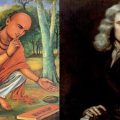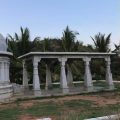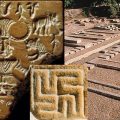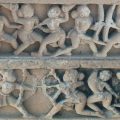Was Paradise in India? An Ancient Autobiography from 13000 Years Ago

In 1996, while in deep meditational states, Mr. Wim Borsboom, the author of this story, accessed a series of memories from the “Akashic Records”. These Akashic memories eventually became the core of the story presented here.
For those not familiar with the concept of Akashic Records please access http://www.crystalinks.com/akashicrecords.html, but here is a short quote:
“Reality is a consciousness hologram. The Akashic Records refer to the hologram (matrix) of consciousness grids that create our reality. One could look upon it as a library […] wherein one can access all information” of the Entire Eternal Cosmos.
It took Mr Borsboom many years to realize the special nature of these memories. He realized that he had come in esoteric contact with the protagonist of the biographical story that follows here, a personage which he eventually recognized to be the same person described, although from a fundamentally different viewpoint, in ancient Hebrew and Christian literature.
So indeed… Adam! But not in the sense of the first created human, but as one of the first human beings who became self-aware, self-realized, enlightened and liberated – a Mukti.
After having written this “autobiographical” account, Mr. Borsboom felt the extreme urge to visit India many times and to immerse himself into its ages-old history.
After visiting especially the north-western parts of India and studying the landscapes of what is now Sindh, Punjab and Baluchistan, he is now convinced that the environments that are featured in this story were once the fertile hills and valleys around Mehrgarh in current Baluchistan, as well as the entire, once fertile river delta in current Sindh, Punjab, Haryana, Gujarat and Rajasthan.
He suggests that this account describes the earliest beginnings of what is currently known as the Indus Valley or Harappan Culture and Civilization, a better term of which would be “Ādi Bhāratīya Saṃskṛti” – आदि भारतीय संस्कृति – pointing at the beginnings of the Bharat civilization and culture.
I had just made my way into the desert and up the dry and arid hills to the east of the river delta where I and my woman life-partner have settled ourselves. Behind me, I can still see the wide valley below, an expanse with wide but shallow rivers and streams, a fertile delta, warm and humid, the sky over it always hazy, a liquid sun just visible.
We live and work in that valley. We tend our gardens and orchards and keep animals. We are homesteaders, a new kind of thing these days, something we are pioneering.
I am climbing up the hillside, but as I’m ascending into some thin misty clouds, quite suddenly the sun breaks through and the mist quickly evaporates. It is getting hot, blazing hot.
Originally, some years ago, before the two of us and a small group of friends settled down in the valley, we lived on the mountainous hills on the Western side of the delta. The wooded hills there used to be shady and cool, they were densely populated by various tribes that were hunters, foragers and gatherers. Lately though all the tribes had also turned into warriors and they seemed to always be at war with each other.
Many years ago those western hillsides had been a tropical jungle full of cedars and fruit laden trees, figs, nuts, berries. It used to be good hunting and it was easy to catch plenty of fowl, also the lakes and streams provided plentiful fish. The food supply had always been abundant, everything ready for the taking.
But… things had changed.
As I am climbing my way up this hot, parched hillside, I’m burning my feet on the hot hard packed orange soil and I’m approaching a part of the hill that is studded with leafless prickly bushes about two or three feet apart from each other.
As I’m making my way through the bushes, a strange sensation overcomes me, a worry coming up in me — fear is trying to raise its head, but although I don’t want to give-in to it, I do want to find out why I so suddenly feel this fear.
I walk carefully through the bushes and then, suddenly, about ten feet in front of me I see a small snake, a viper, about twelve inches long. It is crawling out from underneath one of the bushes and is now slithering towards me. It makes me stop in my tracks, and as I stand there I’m starting to shake, increasing fear almost overtaking me, I am trembling, pretty near stunned…
Back in the forested hills, in the tribe where I grew up, we had learned to fear snakes. We had also been made to be afraid of the wide, often flooding river valley at the foot of our hills, the same valley in which I and my partner now live. We had also been made very fearful of the desert beyond the valley, the deserted, lifeless hills on other side of the delta — hills we could see only during the rare bright days when the air was dry and clear. Actually, we had been made to be fearful of pretty well anything that was not in our own tribe’s hillside territory.
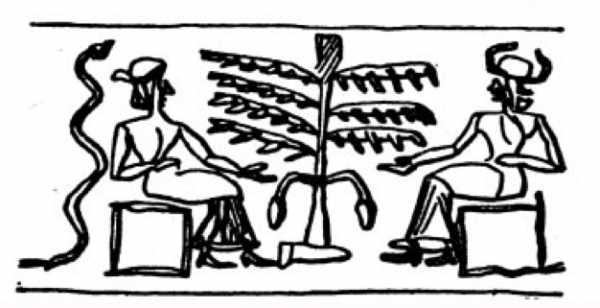
A Sumerian cylinder seal. Left: Enki, the snake man Right: Enlil, the chief
There were two very important people in our tribe, two men to whom we were made to look up.
One was our tribal leader, our horned chief, he demanded our respect. The other one was our ‘man of knowledge’. The “wise man”, him we respected naturally and easily — we called him “Snake Man”.
Of these two men I liked Snake Man the best. He explained life to us, and the nature of things, he helped us understand ourselves. He wanted us to figure out the natural order of things — not for him, but for ourselves.
The other man, the tribal chief, he wielded his power in a rather threatening way, he did things we couldn’t really figure out or understand. He controlled us by instilling fear, using punishment and rewards to get us doing his bidding. He was often angry and it was hard to anticipate his moods. He used to say:
“Don’t ever leave the tribe, I’m warning you! If you ever will, you will surely meet with death. Here you can count on my protection. At least you know what you can expect from me.”
And as he pointed to the valley below and the hills beyond, he added:
“Out there the unknown is very frightening and I tell you, if you ever meet with the unknown, it is going to make you wish you were dead.
Out there also there is no food, the water is bad, and there’s nowhere to hide, there’s nothing out there but poisonous vipers, and only death awaits you.
Out there the unknown is very frightening and I tell you, if you ever meet with the unknown, it is going to make you wish you were dead.
Out there also there is no food, the water is bad, and there’s nowhere to hide, there’s nothing out there but poisonous vipers, and only death awaits you.”
That was his way of holding us in his grip, keeping us tightly bound to the tribe. That’s how the chief worked his powers, how he attempted to exercise control over us. The way he dealt with anybody always included some form of threat or punishment, sometimes mild, sometimes severe… and he often threatened people with death.
Of course his way of dealing with us got copied by many of us and his maneuvers were in turn exercised in a similar manner amongst all of us…
Fear and lack of freedom pretty well fully permeated our way of life and our dealings with each other.
But, come to think of it, we were hardly ever dealt with real death or immediate punishment, and his threats were luckily only sporadically executed — although, when they were, they seemed well timed and dramatically performed.
That surely kept us living in a state of constant fear and uncertainty.
It took me a while to understand why the wise man — Snake Man — said that we lived in a state of suffering and illusion. He wanted us to understand that our “way of life”, the way we normally lived under fear, was actually illusive.
It took me quite a while to realize that we had only been made to believe that the illusion of what could befall us, just seemed to be more real than the freedom that we had been made to believe not to have anymore. The illusive power of fear seemed more real than our freedom which was actually only seemingly taken away by the threatening manipulations of our tribal chief.
Of course in reality the illuded and alluded threats that came from the chief could never allhappen. Just imagine, if he executed every threat (or if others did, who copied his strategies), he would never have any underlings, he would not have anybody to rule over.
The chief must have been well aware of how he used his illusive threats of pain, death and punishment cleverly to confuse us and make us believe that we would never have any freedom apart from that conditional semblance of freedom that he promised if we subjected ourselves to his rules. You see, one single example of killing or punishment, timely performed by him and shown as a dramatic example, would make all of us forever live in fear, as if it could or would befall each of us every moment.
That must have been what the wise man meant when he said:
“You live under illusion, your life — your way of living — is really controlled by the chief’s power of illusion — that constant illusion of fear has made you lose sight of reality and your unconditional freedom.”
I could now identify that fear, it was the same fear I felt coming up in me as I was walking up this hill… I felt it even before I saw the viper.
As I’m seeing this viper winding its way towards me, I’m thinking — thinking quickly:
“Sure there is something to be careful with, but…fearful off…? I have no reason to be fearful. Really, why should I be? This creature has never seen me; it might never even have seen another living being like me. How can it possibly imagine that I might endanger it? Maybe it doesn’t even see me. What do I know about this viper? I certainly have no reason to harm or kill it; the only reason I would have to hurt it is because someone made me fearful of it. It seems that I’m scared only because I was taught that I should be.”
At that moment, a warm feeling welled up in my chest, love actually for that small creature, a care not to scare it. What I feel for this creature is so very different from the fear that I had been taught to have for it. I suddenly became very happy discovering this — ecstatic even — I love that little snake.
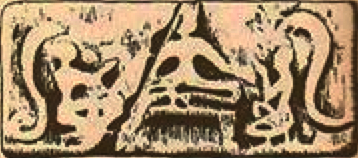
An ancient Indus Valley seal, Mohenjo-Daro
The wise man, our man of knowledge, was very different from most of us… he loved people. Instead of working with threats, he worked with imparting love, knowledge, understanding and insight. To us younger ones he was our friend, we trusted him.
The chief though, we were afraid of him because of the advantage he took of the fear that he had purposely created in us. The wise man on the other hand wanted us to know more about who we were, what we actually are — what it is to be human — that there is more to our being than what we were told by our parents. He taught us about mind and spirit, he even taught us about our body, something he called “your anatomy”.
He would say: “You can learn to know and understand yourself, but you can also learn to know your body and the energies that keep your body alive and living… You’ve all seen people die and you have seen, that after they die, how their bodies fall apart. You have seen that we eventually end up as just a bundle of bones…Now, of all those bony parts that we consist of, some of the most important ones are your backbones, those interestingly shaped bones of your spine”
He did not use the word spine often though, when he pointed to the vertebrae, the bones that our spine is composed of, he called them “serpent bones”.
We knew of course that we were different from snakes, but we could learn something from them, especially the fact that snakes shed their skin. The wise man used that shedding as an example to help us understand how life renewed itself… again and again. What happens to snakes is like a symbol to us:
“Although we humans don’t change our skin like snakes, what snakes do though can help us understand that we humans have many lives… that we live on from body to body.”
It was not symbolic though what the wise man taught us about our own serpent bones. He wanted us to understand how a mysterious energy flows through the back bones of our spine, and that that energy circulates between the top of our head and our tailbone and that it flows — via those back bones — to all the other parts of our body.
As kids we used to collect the small back bones from bird and fowl skeletons, threading fiber strings through the small holes in them, and we wore them like necklaces.
I loved to suck the soft stuff from the inside of those bones. I remember how I figured out that that gooey stuff had the shape of a worm inside the bones, it kept them connected, and that mysterious energy that the wise man spoke about, it somehow flowed through that soft stuff. I concluded that our spine and backbones must be the same as snake bones or even fish bones.
The wise man would ask:
“Don’t those serpent bones look the same as the bones of your own spine? Doesn’t your body contain the same kind of bones?
Well, energy runs through them — life energy — and it goes from the bottom of those serpent bones upwards to where your head is, and it is there — inside your head — that it finds out what you need to do, and it is from there that it tells your body how to do it, and it is there where it helps you doing it. In fact, the most important part of your body are those serpent bones, they not only keep you upright but they also keep all your body parts connected.
Through your spine runs a beautiful power, from the bottom up — from the earth up — and from the top down — from the sun on down — and you take that energy into yourself, and it is that energy that is the origin of life, and it keeps you alive, it keeps everything alive.”
He taught us about the fibers through which that powerful energy runs to all parts of our body. He explained how our intestinal system operates, what lungs are and why we have them and he demonstrated how to breathe properly. He showed us how to handle our body effectively and efficiently.
All that was pretty new to us, I don’t think that anybody in our tribe or any of the other tribes had ever really looked at ourselves that way.
Ah, our wise man! He was the one who had figured it all out. He taught us that understanding creates freedom, and that freedom enables you to find solutions that are appropriate to any problem that may come up.
We very much needed solutions, especially now that we hill-people who until recently were so used to having nature provide plentifully in the wild, had run into challenges that were caused by overpopulation: there were too many tribes in the first place and in addition the tribes were getting too large to sustain themselves without encroaching on each other’s territory.
There was now a shortage of food and game, there was a lack of clean drinking water and especially — because of all those shortages — there were the recent feuds between us and the neighboring tribes.
What had happened was that when the shortages had become too much, our chief and Snake Man had come together to discuss what could be done to overcome the shortages of food and water.
It was an important meeting and us kids (as we still were then) tried to overhear what they were talking about…
I should say that at the time I did not understand anything of what the chief talked about:
“A quick solution! The hunting gear that we use for catching animals in the wild, we can use it on the people of the neighbouring tribes, we can scare them away so that we can take their food or even their territory…”
Snake Man thought that that was a terrible misguided idea:
“Quick and dirty… A disastrous shortcut!Instead, why don’t we use my new discovery of collecting the seeds and nuts that now just fall on the forest floor and use them to plant them on purpose on especially selected spots down below in the river delta where there is plenty of water when up here we have none.We could perhaps also collect swines and mountain goats and gather them in groups — herding them — making sure that instead of hunting them that we can control or even increase their numbers by taking care of their offspring. We can protect them from other dangerous animals that also hunt them. This way we can have a secure and steady supply of food.”
It took some time for Snake Man to make us, the younger ones, understand what he meant, what he was talking about:
“A long-range plan with benefits that would pay-off in the long run.”
That word “plan” was something we had never heard about:
“We can control the future, plan for it, and look after future generations… growing food!”
Who would ever have thought… controlling the future, planning, future generations, growing food!”
Honestly, much of what he said, sounded like gobbledegook to most of us, but then… we young ones loved him, we trusted him and he made us use our “imagination”…
I was able to gather some of the kids around him and he taught us how to go about “implementing the plan, planning for the future,” and he helped us discovering how we could use some of the tools that we used for stripping, hacking and chopping, to instead use them to “till the land”, to “prepare it for the seeds that we would plant.”
We would not have to worry about water, as the valley’s soil was wet enough at certain times to keep the roots moist during the — what he called — “the growing season”…
Unfortunately, the chief’s “short-cut plan to raid food from others and to scare the neighbouring tribes away” was easier to understand. Instead of rounding-up wild animals and catch them, we could just scare the other tribes’ people away.
“Chase them away with your weapons, you don’t even have to catch them…!”
Most agreed:
“What a marvelous quick solution!”
Sure, it was so much quicker, and easier to understand by our older tribal members and many of their kids.
Well, it was the “short-cut” that was first implemented, while we, the more studious ones, were learning new skills and anticipating the next “planting and growing season.”
Pretty well all of the tribal members went for the short-cut… “waging war!” it was called, and initially it did paid off, but, although at first we would would come out “winners”, all too quickly the other tribes copied our “strategies” and winning often became “losing.”
Yes, many new words were invented and used. The older people and most of their kids caught on quickly, but some of us younger ones, the more “clever” ones, used our imagination for other purposes, we invented new tools, we learned to “look into the future” and we had to learn to “trust”… would the seeds and nuts that we collected really grow new trees and plants, and would the tubers grow in other places after we dug them up and planted them in the valley’s soil down below?
Yes, we trusted and waited, but in the meantime many disasters took place with the warring: we killed many members of the other tribes, and even some of our own fiercest “warriors” got killed as well.
The tribal chiefs tried to solve the problems by setting up “peace” meetings, but it was impossible as one new word stood out: “revenge” and revenge worked both ways… for us and against us.
In fact whatever was done in terms of raids, hunts and “peaceful solutions,” any attempts to deal with the warring and the shortages only caused the problems to become larger, and… people even died from causes we did not even know the cause of…
While the little snake was still slithering towards me, I suddenly discovered — surprising myself:
“Wow, I don’t have to be afraid. This animal is like our own serpent bones that keep us together and upright. That little snake and myself actually have something very important in common!”
And as I’m thinking this, I am getting quite ecstatic, the hair in my neck is standing on end and it’s like I am starting to float in the air, it feels like I am rising up from the red soil upon which I am standing.
At that point, I’m becoming aware of something that I had never felt before… there seems to be something like a large bubble around me, and I know what it is! It must have to do with that energy that the wise man always talks about, it is inside me, but now I feel it is also around me. It is something that I up to now had never really fully understood.
I feel myself floating even more.
And that viper…? It just slithered away easily between my feet and nothing of what I was at first worried about that could happen, did actually happen.
I was totally amazed at what I had just discovered. I now know for sure that our chief instilled fear in us rather than giving us freedom — he enslaved us so that we became useful for his purposes… to his benefit and our detriment. This man, our tribal chief talked about badness in the world, that there is good and evil, that the fights we are having with the other hill tribes are actually about the fight between good and evil. He even assured us that those on our side were good and those who were not with us were evil.
That can not be so, I just know it. It is clear to me now. That is the story we are being told to make us fearful so that we do the chief’s bidding, so that we would fight his wars. It just can not be so!
There is no evil except for something very illusive that is cleverly and craftily put in our heads, something which we are tricked into believing to be real, but which actually is not.
Our minds have been filled with fear so that we cannot see anymore what’s really real…
I just met this snake that didn’t do anything to me at all, although it was supposed to be harmful, and I was supposed to be fearful that it would hurt me… that it would even kill me.
We were just made to believe that there are evil powers in the world outside our tribal confines and that only our chief was able to protect us from those who were so to speak evil.
I now realize there is no evil as opposed to good. You see, that distinction you won’t find anywhere in nature, only in human nature… in the denatured human really!
Those assumed opposites don’t exist as such. They only exist as ideas in our confused minds.
First that false idea took a hold in the mind of the chief who intended to use it to create fear, and subsequently it overtook the minds of those in the grip of his spells, their unsuspecting minds now filled with fear and false ideas of opposing and conflicting forces… the flawed notion of good versus evil as though those opposites exist in reality and are so to speak needed to balance each other out… as though they depended on each other in some strange devious way!
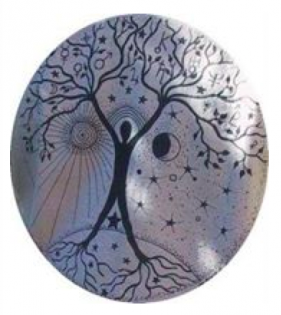
From a 2006 T shirt
As I was realizing this with great clarity and insight, it was as though my body started to rise even higher and I felt an enormously powerful energy coming up from deep below me… from the earth itself. The earth actually felt like an enormous globe beneath me!
I never realized that the earth was like that, and I suddenly knew that we live on a beautiful, large living entity…
The earth itself is a living being.
Then it felt as though my spine became like the trunk of an enormous tree, erect and massive, its roots growing from me deeply into the earth, spreading ever so widely throughout the whole earth, the very soil from which we have grown, from which we originally came forth.
I then became aware that my arms grew into branches that were expanding wider and wider into the heavens, and as I was spreading out, the glorious sun was glowing ardently down into my whole being.
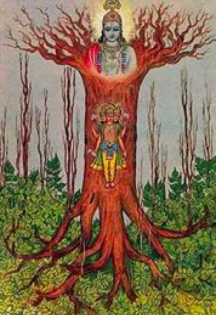
“The Indestructible Banyan Tree” – Sacred Upside-Down Cosmic Tree, Hindu mythology
(“There is an eternal tree called the Ashvattha, which has its roots above and its branches below. Its luminous root is called Brahman, the Supreme Reality, and it alone is beyond death. Everything that exists is rooted in that point. There is nothing else beyond it.” – Katha Upanishad.
Quoting Linda Johnsen, “India’s ancient sages literally placed the tree in the sky. Go out at night and look up at Scorpio, near where the ecliptic (the path of the sun and planets) crosses the Milky Way. There you’ll find a small constellation in the tail of the celestial scorpion which the yogis call Mula, “the root.” This is the root in heaven out of which the World Tree grows. […] If you follow the spray of stars backward through the zodiac you’ll see the Ashvattha’s trunk growing through Scorpio, its limbs branching out in Libra (the Indian constellation Vishakha here means “forked branches”), and fruit growing on its branches in Leo and Virgo (the Indian constellation here called Phalguni means “fruit of the tree”). The ancient sages placed a young woman here named Kanya (our Virgo). With one hand (our constellation Corvus is called Hasta, “hand,” in India) she’s reaching for the fruit. And there entwined in the tree next to her is a long snake we call the constellation Hydra, which the ancient Indians called Ashlesha, “king of the serpents”.”)
All-this-right-here became energized by the widest expanse of the earth and the universe and I felt how each one of us is actually a channel through which earth and heaven communicate.
It was as though the sun, which first stood straight above me, was now coming down into me, surging its energies throughout my whole being, my branches and leaves invitingly embracing the sun’s rays that were suddenly forming an energetic crystalline star hovering about a foot above my head.
As I looked up into it I immediately knew that it was somehow part of my whole being. No, even more, it felt like it was the core of my being.

A 3d wire model of a dodecahedron containing the Five Pythagorean Solids — By Dan Winter.
As that crystalline star descended into me, my earth-like energy also ascended into it, and our energies all merged into one another.
I then could look into the shape and I distinguished a huge crystal-clear gem. Inside the gem I saw vibrationary patterns that were taking on the form of a multi-faceted star, its bright lines joining the many connecting points into a complex multi-shaped figure that at once held many geometric shapes inside each other, a cube, a tetrahedron and a few more multifaceted shapes.
The points and edges themselves were of a deep scintillating blue, but the whole formation showed itself at once while gyrating seemingly in all directions and sparkling in a myriad of vivid but pastel-like colors.
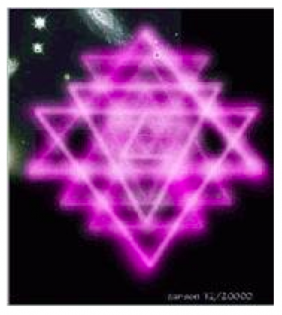
Sri Yantra, painting by Susan Carlson
As the crystal merged into me, my chest inside opened up so widely that it was as though my inside received this divine energy as the greatest gift in the highest state of glorious bliss. Then I suddenly felt as though I was exploding into the whole universe, being at once the whole universe, as well as all its constituting parts and I realized the divinity of it all.
All and everything divine and each individual part uniquely so!
After a while I came down from this intense state, and as I squatted, my hands holding my face, elbows resting on my knees, I caught myself gazing far down into the distant valley below, ruminating my thoughts, thoughtfully focusing on the work my partner and myself were doing down in the valley.
A little later in the day, after my return to the valley, I met up with my her and I told her of what had happened to me. She — this being of life — was not at all surprised, as my story so much backed up and supported her own awareness and experience.
The wise man always said to us:
“Know yourself!”
but also,
“Find out for yourself!”
Now I realize that he meant not just to believe someone based on their authority, but to find out and experience for yourself:
“You can at some point know directly and personally what I now can only point out to you.”
Maybe my partner because she is a woman always already experienced this energy more directly. Hmm… did she not carry life already, bringing forth life?!
Maybe women have an innate trust in the way nature works, the way life goes.
I’m sure that over time men have been compromised too much by fear — and anger too — perhaps in order to get motivated for their hunting escapades… or now, more recently, in their wars with the neighboring tribes.
This belief in good and evil, that whole notion is flawed!
I get it!
Evil is a ‘thinking thing’, one does not actually see evil, one may be seeing accidents or inadvertent things that do happen (by all appearances catastrophes are an inescapable part of nature), but in addition, under undue pressure, one has been forced to develop a certain kind of imaginative thinking, caused and enhanced by fear that at the same time increases it and creates subsequent suspicion, skepticism and habitual questioning — all in all a total lack of unconditional trust. This in turn creates a certain kind of imagery — illusion — something that so characterizes our human suffering. This way an added layer of suffering gets created mentally, something that envelops the natural occurrences of pain and natural discomforts.
This man-made suffering causes one to see, experience and interpret things that actually and naturally happen differently, different from the way they were seen and witnessed before the illusive fearful imagery comes into play.
It is quite arbitrary really, anything that looks good to one person, can look like evil in the eyes of somebody else. Flawed thinking makes you see things differently, it makes you interpret everything differently from when you just simply observe. Thinking can be good, of course it can be, when it is pure and unadulterated, but it can also make that, what you normally know as right and straightforward, look strange, crooked, bad or even evil, and… it might get you to make other people think and experience poorly and falsely as well, and thus they subsequently also might get into situations of abusive strategizing, maneuvering and manipulating.
Many years ago, before my partner and myself — then still a couple of youngsters — descended into the valley, the wise man had been talking a great deal about cause and effect, “causality” he called it:
“In nature everything is causally related to everything else in a mutual and reciprocal way. Causality, when we don’t interfere with the natural flow of things, affects other things in a complex and dependable manner. The problem is, we humans somehow learned to interfere with the natural course of things, and we have been able to cause changes that without us would not have taken place’”
The wise man pointed out how it was sometimes hard to figure out if the changes were actually what we wanted or not. He told us:
“Years ago I discovered that it is possible to glean something very simple and useful from this the complexity of cause and effect. It can be used to our advantage when the results are clearly foreseen and planned to be advantageous to the furthering of life. I discovered that it was possible to intervene in the natural processes of cause and effect and that — providing it is used for the good of life in general — that no adverse side effects would accompany the results.”
The wise man’s main discovery was how in the natural order of things “cause and effect” was also two-directional and not necessarily linear as far as time goes.
His discovery was not at all the action-reaction or the eye-for-an-eye strategy that it eventually became for the tribes who remained on the hillsides and who from there ventured into other lands taking their own misguided ways with them.
Unfortunately they had learned to resist causes by replacing their natural effects with counter actions.
Human nature had become pseudo-nature,
different from our authentic original pure nature.
Part 2
Whoever reads this now — thirteen thousand years after my story here — should realize that the sages and smart people of your current age are not any wiser or more intelligent than the sages of my time. The insight and engineering skills needed to conceive of making fire, cutting flint, chipping arrow heads and adzes and later forging them from iron, the invention of pottery and the wheel, were as involved as you now are figuring things out with the tiniest entities conceivable that are being experimented on in the largest machines possible. In fact, in our days — for you so long ago — it was not like Isaac Newton who “could stand on the shoulders of giants before him” who helped him “to see farther.”The original sages and inventors had to pretty well start from scratch! Let me describe how life was before we young ones, moved down into the river valley from the hillsides.
The population of the tribes on the forested hills had been expanding rapidly over the last generations, and the supply of food from the hunts and from what was available from foraging had been dwindling fast also because of long periods of drought. We now had to compete with our neighbors for larger hunting grounds as we had pretty well run out of game in our own territory. All of the tribes experienced the same problem and we couldn’t figure out how to get more food in a peaceful manner other than by raiding the neighboring tribes. As explained before, on the advice of our chief, we resorted to ugly tribal warfare, and that is what all the tribal chiefs eventually had their own people doing as well. The wise man though, our man of knowledge, who had become a mentor to some of us, especially to our tribe’s younger members, started to teach us that there was a way out of this.
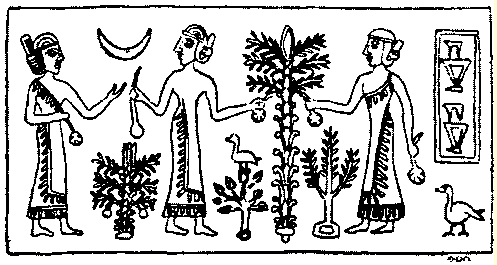
Left: Enki teaching silviculture, horticulture and poultry keeping. Mesopotamian seal
As mentioned already, he had discovered some predictable regularity in the way things follow up on each other — cause and effect. He had drawn his initial conclusions mostly from the way seeds fall from plants and trees and then — after — turn into new plants or trees. He also saw that most seeds did not turn into new plants and he wondered how and why that did not happen. He eventually saw that when you set the conditions right with moisture and sunlit spacing that they would turn into new plants.
He was always looking, observing and drawing conclusions.
The wise man predicted things,
not because he could look into the future
but because he understood the past.
He had figured out how things happen, that there are natural laws or rules that nature follows, and by knowing those rules he could foresee what would happen. But also, and that was his greatest discovery, by following those rules and applying them to seeds and animals, he could change the future and… he could foresee and foretell how things would change.
Nobody had ever thought that way. There was security in his ways, not the fear of never knowing what would happen:
“Things that happen are not a matter of blind chance, nor luck, neither do they depend on boons, prayers and mysterious ceremonies.”
That was the kind of thinking behind everything he did. But recently that thinking was also behind his experiments with the seeds he collected and planted, and with the tame animals he had us breed from the wild mountain goats and mountain sheep.
He got those of us who were interested, to start collecting seeds, gathering up certain animals and he suggested that we eventually move down into the river valley, planting the seeds in an ordered and planned manner. He suggested how we could take care of the animals that we had set aside, to stay with us for herding. Maybe we could do that even better with some especially prepared animals that would take more easily to the humid environment of the valley down below. The wild boar could probably be transferred too, but surely the newer breed of sheep and young goats. He predicted that if we did this according to his prescribed ways, we would always have an abundance of food.
He did other curious things with seeds: he “calculated” with dried beans and nuts that he laid out in front of himself in neat patterns.
He could tell from the patterns in which the beans were laid out how large the next “crop” — that’s how he called it — would be, or how the herd of cattle would grow in number.
We could now make use of land that we had thought to be taboo to us or just waste land. Before our experiments, the muddy valley did not grow much that was of any use to us, but now, he said, that land was waiting for us to be “cultivated.”
He invented new words for things he had understood and helped us to acquire the same understanding and learn those new words.
Where he usually sat, he always had a clean flat spot of hard dirt in front of him and with a stick he would scratch shapes in it and he would apply sounds to those scrapes. He even made a string on which he first strung little bones or small shells with a hole through them. He organized them in certain sequences that he gave special sounds to, “numbers” he called them and he would have us repeat the words after him as he uttered them.
Later, with a similar string but now with knots, he would make shapes that we had never seen before: straight lines, triangles, rectangles, squares. He could also make the most perfect circles and other round shapes with his strings.
We kids loved him… we would lay out shapes like he did, using small pebbles, twigs and strings and he would get it right for us if it did not work out well at first.
Years later in the valley, we would use his methods to lay out plots of land and build buildings from sun baked bricks of clay. The shapes of those bricks were made with strings that were divided into twelve parts; when you folded the strings just right the bricks were always straight and they all had the same size. The strings he had us use were always divided into twelve small sections and the wise man always had us count them in two ways, either in sequence or he had us divide them up in groupings of three, four and five. That was especially handy as we kids also wanted to make his ‘magic’ shapes, triangles, squares, circles and spirals… snake forms.
In the past, before the overpopulation in the hills, when there was still enough roaming area available, the tribes lived an ambulant life moving through the forests between the hills from dale to dale. If we would move down into the river valley we would also have to live a more or less ambulant life in order to deal with the unpredictable flooding each year. That’s why many of us thought that taking up life in the wet river valley with its many floods was unwise. The wise man though had been studying the floods and discovered a certain regularity to them. The larger floods always came from the mountain rivers once every “twelve moons” as he called it. The smaller and more frequent floods always came from the sea and had to somehow also to do with the moon, but those smaller floods tended to happen twice a day, and he predicted them very accurately.
He suggested that we could organize our movements in the river valley around the predicted floodings. What if we would go down into the wider flatter and slightly higher areas whenever it was possible and safe, we could always return to “higher ground” closer to the hills when it was not as safe and accessible. In addition, there would always be drinking water in the river valley while on the hills during the dry periods we would always run out. Also, in the valley, sunshine was always filtered by the low thin clouds of humid air, it would be warm but not as blazingly hot as certain times of the year in the hills, and hopefully there would not be as many thunderstorms and wild-fires down in the valley.
The wise man foresaw that if we created the right environment in the valley, we could grow shrubs and trees that would produce the fleshy fruits like figs that we liked so much, or the stone apples that we learned to chop up and press for their juice, or the trees that would provide us with the nuts that we so fondly collected in the hills. He foresaw that we would even grow large areas of those grassy weeds of which the kernels were so tasty.
To most of us eager youngsters it made so much sense, and although it had never been done before, we felt that anything would be better than the wars, bloodshed, strife, revenge and hatred.
My girl-companion and I decided to take it on. We decided to move down into the valley. We actually started planting saplings from some fruit trees that we thought would grow fast and tall enough to deal with the shallow flooding on the edges of the valley. We also started to grow grasses of which we were able to get the grains grow larger than in their wild form. We planted a kind of tree of which the fruit was more edible than the quince fruits that we had learned to chop up and cook and press for their juice and jelly.
The young mountain sheep and young goats took very well to the valley’s expanse. We started collecting more animals and settled down for longer stretches of time — we called it “husbandry” — although we had to keep moving quite often according to the vagaries of the rivers.
It was good that we had left for the wider delta as the feuds and wars kept increasing and many tribal members were killed. But our chief, instead of following the advice of the wise man, was fearful that he would lose his power.
The wise man foresaw that, instead of the older women still foraging, many of the youngsters — young women as well as young men — would start to grow their own food, fruit, nuts, roots. And instead of older men hunting, these same youngsters would have their own animals for meat and milk! They would be independent!
What would happen to the traditional role of men and women, women not collecting and preparing food, men not hunting, not being ready for tribal defense and raiding others tribes?
That was not to happen, the chief decided:
“The youngsters would be free?! No, that will never be!”
That way the old way of life would have no use anymore, he wouldn’t be able to pressure anybody to follow his orders. The chief eventually sent his fighters into the delta.
In the meantime we had increased in number and the hill people who came down into the valley to fight us, could not prevail over us as they were lacking food, and as they tired out quickly on the treks they had to make to reach us. Also, as the terrain was flat, there was no way for them to gain an advantage… there was nowhere to hide. In addition we knew about the timing of floods and found many ways to escape them or instead have them land-locked.
They eventually withdrew and we were able to attend to our farming practices uninterrupted and in peace.
After one especially good growing season we decided to send a group of us back to the hills, and visit not only our own tribe but various others as well. As we had inflicted no harm while we defended our independence, we intended to convince our tribal brothers and sisters who still lived in the hills, that the way of going about living our new way — being free and self-sufficient, being able in the ways of animal husbandry and agriculture to produce food in a steady dependable way — that it was a better way of life in these new times. We showed them that one could live peacefully again, that one could trust again without fear of manipulation and wars.
Gradually we gathered more followers. The chief however became immensely upset and got the visiting groups rounded up and he banned them from ever returning to the hills. Also he placed guards so that no one from the hills could move down into the valley below.
We now knew that we would take up living in the valley permanently and in increasingly large numbers. Of course the old chief blamed Snake Man, our man of knowledge for our “misguided and evil way of life.”
There was an interesting encounter once, when the old chief came down from the hills into the valley for a secret visit to one of our gardens in the valley. Initially he spied on us… or was it perhaps voyeurism? When he was found out, he cursed us forever as he lost his cool…
But that story is already known in a biblical way ****, although I’m sure that, as that story got passed on and was told and retold again, that it became a story that was the opposite of what had actually taken place.
Notes
* First published in 2006,
- In 1996 I accessed a series of Akashic Records memories.
( http://www.crystalinks.com/akashicrecords.html )
This autobiographical short story is a compilation of those recollections. - The bolded text throughout this account is a word-by-word retelling of one major episode from those Akashic memories.
The non-bolded text is a compilation of other Akashic memory segments and subseqent musings related to those memories.
** http://www.bbc.co.uk/news/science-environment-23536567
http://phys.org/news/2013-05-comprehensive-analysis-impact-spherules-theory.html
About 12980 (+/- 5) years ago (possibly shortly after the occurrences that are described in this account took place) a meteor impacted on earth that according to the above news reports caused extensive wildfires as well as global temperature drops. (However, no mass extinction, etc.!)
I suggest that the cherubim (plural) and the fiery sword(s) was the biblical equivalent of reporting this event. An event (see note ***) that may have caused the valley not to be accessible from the hills anymore.
I also suggest that this might even have accelerated the successful development of agriculture and animal husbandry.
*** According to the time-distorted biblical accounts, “God” cast “Adam and Eve” out of “paradise” and positioned cherubim (angels) with flaming sword(s): “And the LORD God said, ‘The man has now become like one of us, knowing good and evil. He must not be allowed to reach out his hand and take also from the tree of life and eat, and live forever.’ So the LORD God banished him from the Garden of Eden to work the ground from which he had been taken. After he drove the man out, he placed on the east side of the Garden of Eden cherubim and a flaming sword flashing back and forth to guard the way to the tree of life.” (Genesis 3:22–24).
Wim Borsboom
Latest posts by Wim Borsboom (see all)
- Out of India Theory: Did Ancient Indians Migrate Outside by Land or Sea? - July 27, 2024
- Memory, Mimicry, Symbolism and the Evolution of Homo Sapiens - July 27, 2024
- Towards India’s New Era Paradigm: Reformulating Karma and Past Lives - July 27, 2024

